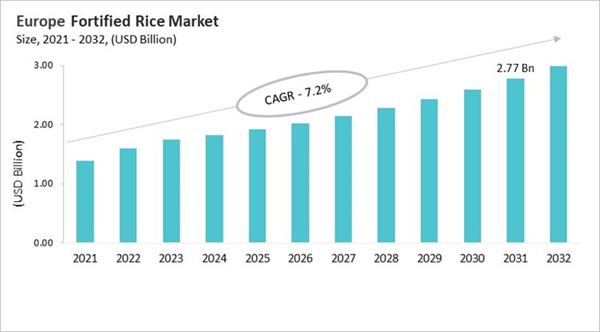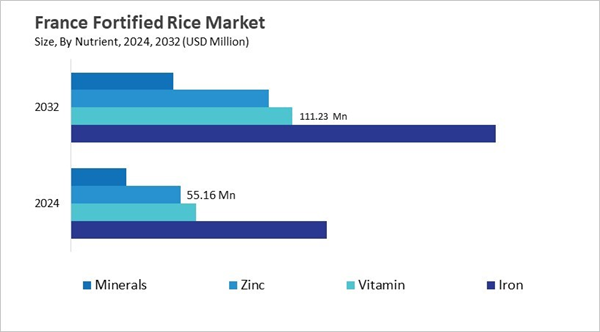The Europe Fortified Rice Market is expected to witness market growth of 6.5% CAGR during the forecast period (2025-2032).
The Germany market dominated the Europe Fortified Rice Market by country in 2024, and is expected to continue to be a dominant market till 2032; thereby, achieving a market value of $534.4 million by 2032. The UK market is exhibiting a CAGR of 5.5% during 2025-2032. Additionally, the France market is expected to experience a CAGR of 7.3% during 2025-2032. The Germany and UK led the Europe Fortified Rice Market by Country with a market share of 20.1% and 17.3% in 2024. The Spain market is expected to witness a CAGR of 7.8% during throughout the forecast period.
Europe's fortified rice market has developed in a distinct regulatory and cultural context, influenced by strict food safety regulations, wary consumer sentiments, and a lower dependence on rice as a staple than in Asia or the United States. When fortified rice was first implemented through pilot programs run by agencies like the World Food Programme, it proved successful in institutional contexts like hospitals and schools, opening the door for wider adoption. Over time, fortified rice has been able to enter select markets thanks to EFSA's regulatory oversight and voluntary national guidelines. Additionally, policy frameworks like the EU's Farm to Fork strategy have positioned fortified rice as a tool to address micronutrient deficiencies and further sustainability goals.
Three primary trends characterize the current market growth: gradual entry into multicultural urban retail markets, expansion of institutional catering systems, and alignment with EU sustainability and health strategies. The ability of suppliers to satisfy stringent regulatory and procurement requirements shapes competition more so than mass retail branding, with cost effectiveness, compliance, and trust acting as important differentiators. By integrating fortified rice into institutional procurement, connecting it to sustainability objectives, and focusing on niche consumer segments through transparent and culturally appropriate communication, industry leaders bolster their position. As part of Europe's larger public health and food sustainability agenda, fortified rice has become a recognized and focused nutrition solution thanks to its careful but calculated expansion.
The Germany market dominated the Europe Fortified Rice Market by country in 2024, and is expected to continue to be a dominant market till 2032; thereby, achieving a market value of $534.4 million by 2032. The UK market is exhibiting a CAGR of 5.5% during 2025-2032. Additionally, the France market is expected to experience a CAGR of 7.3% during 2025-2032. The Germany and UK led the Europe Fortified Rice Market by Country with a market share of 20.1% and 17.3% in 2024. The Spain market is expected to witness a CAGR of 7.8% during throughout the forecast period.
Europe's fortified rice market has developed in a distinct regulatory and cultural context, influenced by strict food safety regulations, wary consumer sentiments, and a lower dependence on rice as a staple than in Asia or the United States. When fortified rice was first implemented through pilot programs run by agencies like the World Food Programme, it proved successful in institutional contexts like hospitals and schools, opening the door for wider adoption. Over time, fortified rice has been able to enter select markets thanks to EFSA's regulatory oversight and voluntary national guidelines. Additionally, policy frameworks like the EU's Farm to Fork strategy have positioned fortified rice as a tool to address micronutrient deficiencies and further sustainability goals.
Three primary trends characterize the current market growth: gradual entry into multicultural urban retail markets, expansion of institutional catering systems, and alignment with EU sustainability and health strategies. The ability of suppliers to satisfy stringent regulatory and procurement requirements shapes competition more so than mass retail branding, with cost effectiveness, compliance, and trust acting as important differentiators. By integrating fortified rice into institutional procurement, connecting it to sustainability objectives, and focusing on niche consumer segments through transparent and culturally appropriate communication, industry leaders bolster their position. As part of Europe's larger public health and food sustainability agenda, fortified rice has become a recognized and focused nutrition solution thanks to its careful but calculated expansion.
Category Outlook
Based on Category, the market is segmented into Conventional and Organic. With a compound annual growth rate (CAGR) of 5.1% over the projection period, the Conventional Market, dominate the UK Fortified Rice Market by Category in 2024 and would be a prominent market until 2032. The Organic market is expected to witness a CAGR of 6.7% during 2025-2032.Nutrient Outlook
Based on Nutrient, the market is segmented into Iron, Vitamin, Zinc, and Minerals. Among various France Fortified Rice Market by Nutrient; The Iron market achieved a market size of USD $213.5 Million in 2024 and is expected to grow at a CAGR of 6.7 % during the forecast period. The Zinc market is predicted to experience a CAGR of 7.9% throughout the forecast period from (2025 - 2032).Country Outlook
The market for fortified rice in Germany is growing slowly under a strict food safety and regulatory framework that gives priority to proof of efficacy, safety, and compliance. Rice fortification is progressing primarily in areas that address practical nutrition gaps, especially iron and folate intake, without changing taste or cooking methods, in contrast to flour or dairy substitutes. Rice consumption is driven by institutional catering and immigrant communities in major cities like Berlin, Hamburg, and Frankfurt. Municipal procurement guidelines for healthcare, education, and elder care that are in line with EU Farm to Fork's objectives for sustainable and healthful food production influence growth. Market dynamics prioritize timely supply, traceability, regulatory-compliant labeling, and dependable nutrient delivery following cooking over branding. Fortified rice is gaining a small but steady place in catering cycles and specialized retail markets as public pilots grow and procurement regulations become more stringent.List of Key Companies Profiled
- DSM-Firmenich
- BASF SE
- Cargill, Incorporated
- Olam International Limited
- General Mills Inc.
- Bunge Limited
- KRBL Ltd.
- Buhler Group
- LT Foods Limited
- Wilmar International Ltd
Market Report Segmentation
By End User
- Off-trade
- Supermarkets & Hypermarkets
- Convenience Stores
- Online stores
- Specialty Stores
- Other Off-trade Type
- On-Trade
By Category
- Conventional
- Organic
By Nutrient
- Iron
- Vitamin
- Zinc
- Minerals
By Country
- Germany
- UK
- France
- Russia
- Spain
- Italy
- Rest of Europe
Table of Contents
Chapter 1. Market Scope & Methodology
Chapter 2. Market at a Glance
Chapter 3. Market Overview
Chapter 6. Competition Analysis - Global
Chapter 11. Europe Fortified Rice Market by End User
Chapter 12. Europe Fortified Rice Market by Category
Chapter 13. Europe Fortified Rice Market by Nutrient
Chapter 14. Europe Fortified Rice Market by Country
Chapter 15. Company Profiles
Companies Mentioned
- DSM-Firmenich
- BASF SE
- Cargill, Incorporated
- Olam International Limited
- General Mills Inc.
- Bunge Limited
- KRBL Ltd.
- Buhler Group
- LT Foods Limited
- Wilmar International Ltd










